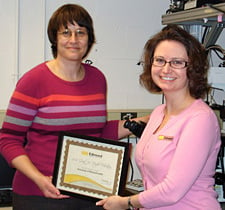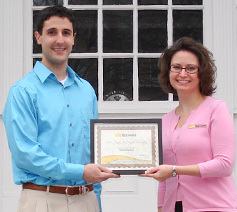

University of Massachusetts, Amherst — submitted by Lori Goldner
First place recipient Dr. Lori Goldner, Professor of Physics, is developing state-of-the-art optical equipment that allows microscopic examination of single biomolecules and their interactions with their environment. Tightly focused laser beams serve as "optical tweezers" to position sub-micron-sized droplets of fluid that contain the molecule, acting as a tiny test tube. Dr. Goldner can then investigate the structure and actions of the molecule using a confocal fluorescence microscope. These techniques have application both in biochemistry, where they allow detailed examination of molecular interactions such as those between proteins and RNA, as well as in physics, where they can be used to observe how biomolecules assemble into complex structures such as crystals and tubes. Ultimately, the studies will aid in the development of more effective drugs and advanced nanofabricated materials.
In addition to conducting advanced research in optical techniques for biophysics, Dr. Goldner is a superhero mentor to her students. She has made her laboratory equipment available to her students so that they can gain first-hand experience with the tools and techniques they will need to use in their own work after graduation. Her intention for the grant award is to fabricate optical tweezers and other advanced optical tools that can be dedicated to student use.
University of Southern California — submitted by Armand R. Tanguay, Jr.

Second place recipient Dr. Tanguay, Professor of Electrical Engineering, Materials Science, Biomedical Engineering, and Ophthalmology is developing an ultra-miniature camera that can be implanted in the human eye and connected via a microelectrode array to the retina, with the ultimate goal of restoring sight to the blind. Previous retinal prostheses, already in clinical trials, used an external camera mounted on eyeglasses, requiring extensive head movements to scan the environment. By contrast, the intraocular camera's location within the sac that normally contains the eye's lens allows for a natural coupling of head and eye movements. The degree of camera miniaturization required is made possible by studies of the visual psychophysics of human vision in the low resolution limit, which in turn relaxes key imaging constraints. This project involves an interdisciplinary collaboration with retinal surgeon Dr. Mark S. Humayun at USC, and holds long-term promise for restoring functional vision to victims of degenerative diseases such as Retinitis Pigmentosa (RP) and Age-Related Macular Degeneration (AMD).
Like Dr. Goldner, Dr. Tanguay is passionate about both undergraduate and graduate teaching, and is a Distinguished Faculty Fellow of the Center for Excellence in Teaching at USC. His classes are often enlivened by a tour of the National Science Foundation Engineering Research Center on Biomimetic MicroElectronic Systems at the USC Keck School of Medicine, where several volunteers experience different blindness conditions as well as the restoration of their sight while navigating through the laboratory wearing a visual prosthesis simulator.
Tufts University — submitted by Corey Shemelya

Third place award recipient Corey Shemelya, a graduate student in Electrical Engineering, is working on the development of optical tools for the evaluation of materials used in photovoltaic and thermophotovoltaic power generation. The tools will support his research into material selection and processing for the fabrication of these two different device structures. While concentrating photovoltaic cells should achieve conversion efficiencies of over 50%, which is a significant improvement, the thermophotovoltaic cells could be used to improve the energy efficiency of any device by harvesting waste heat.
or view regional numbers
QUOTE TOOL
enter stock numbers to begin
Copyright 2024, Edmund Optics Singapore Pte. Ltd, 18 Woodlands Loop #04-00, Singapore 738100
California Consumer Privacy Acts (CCPA): Do Not Sell or Share My Personal Information
California Transparency in Supply Chains Act